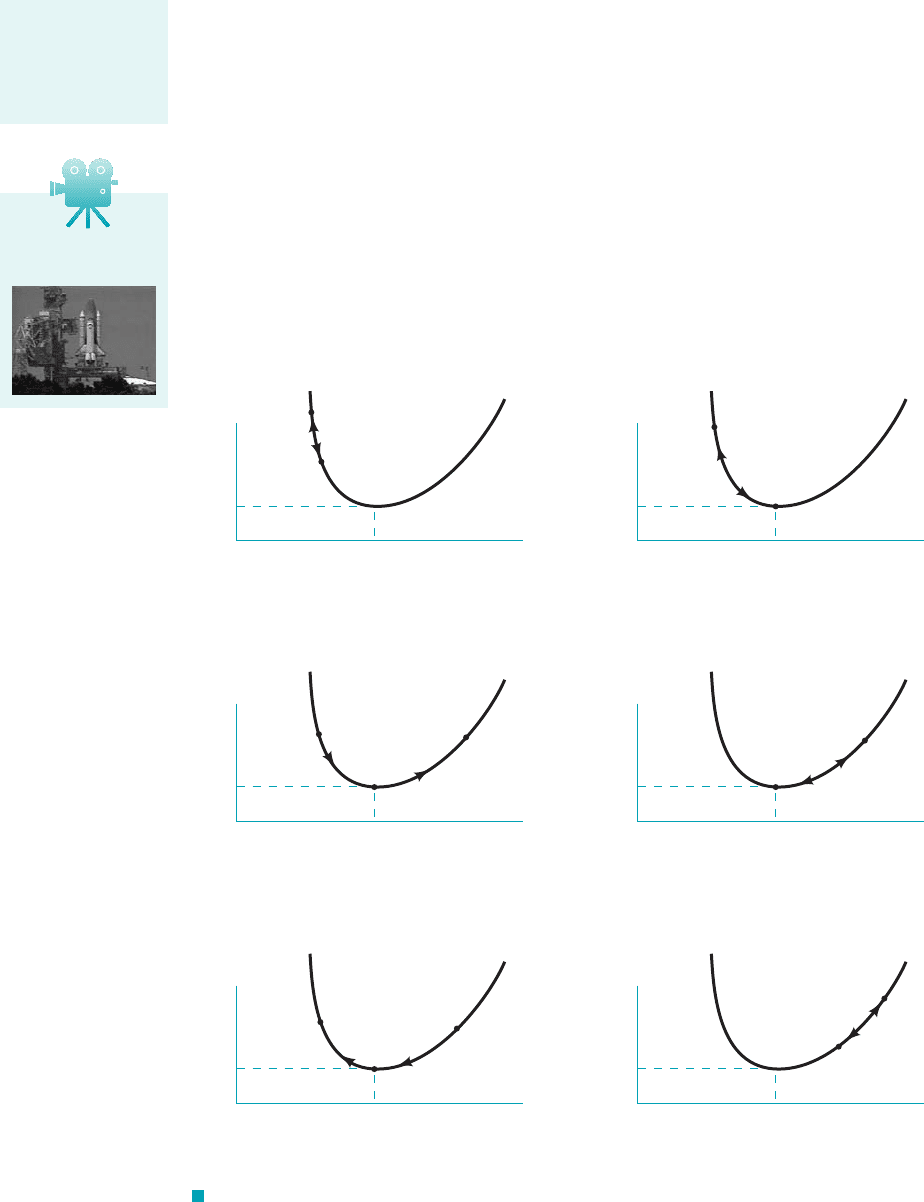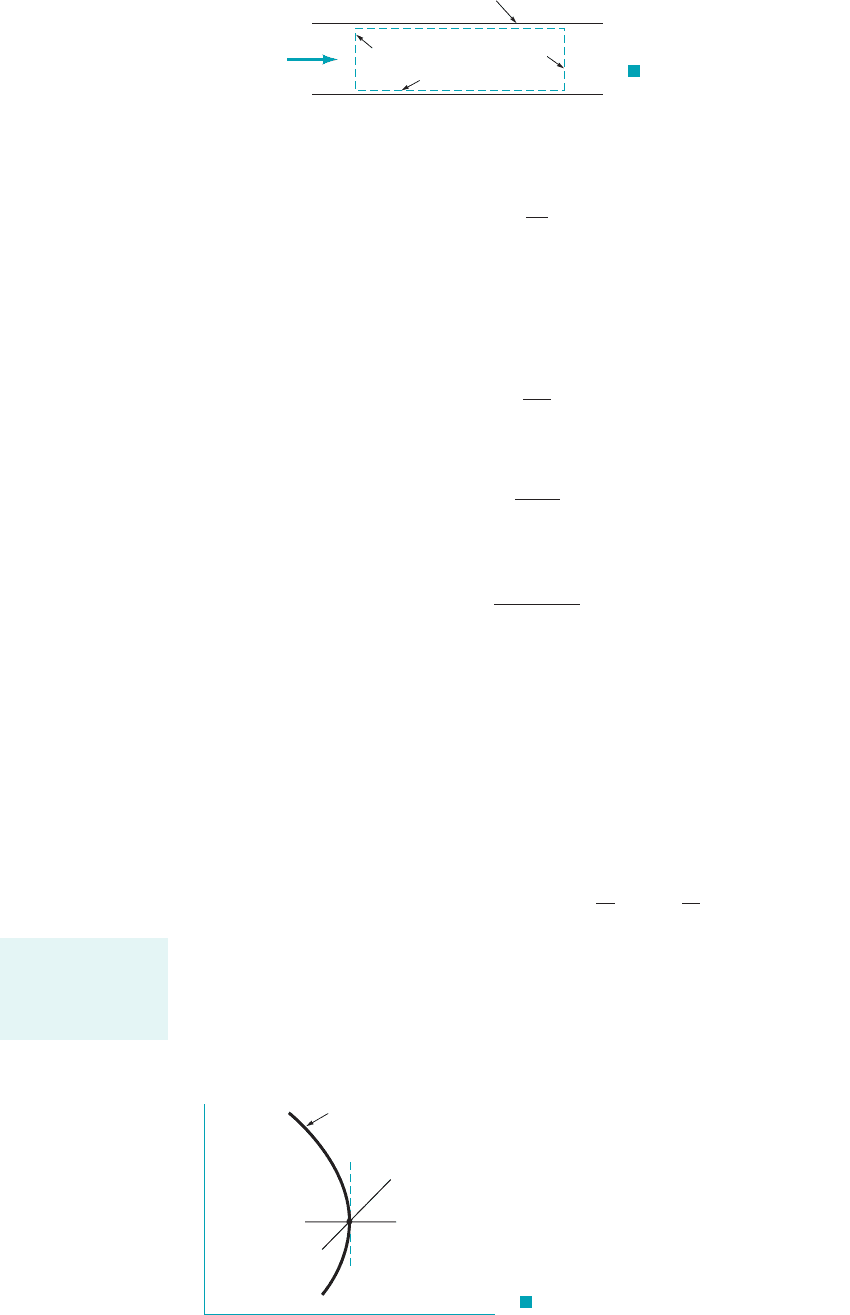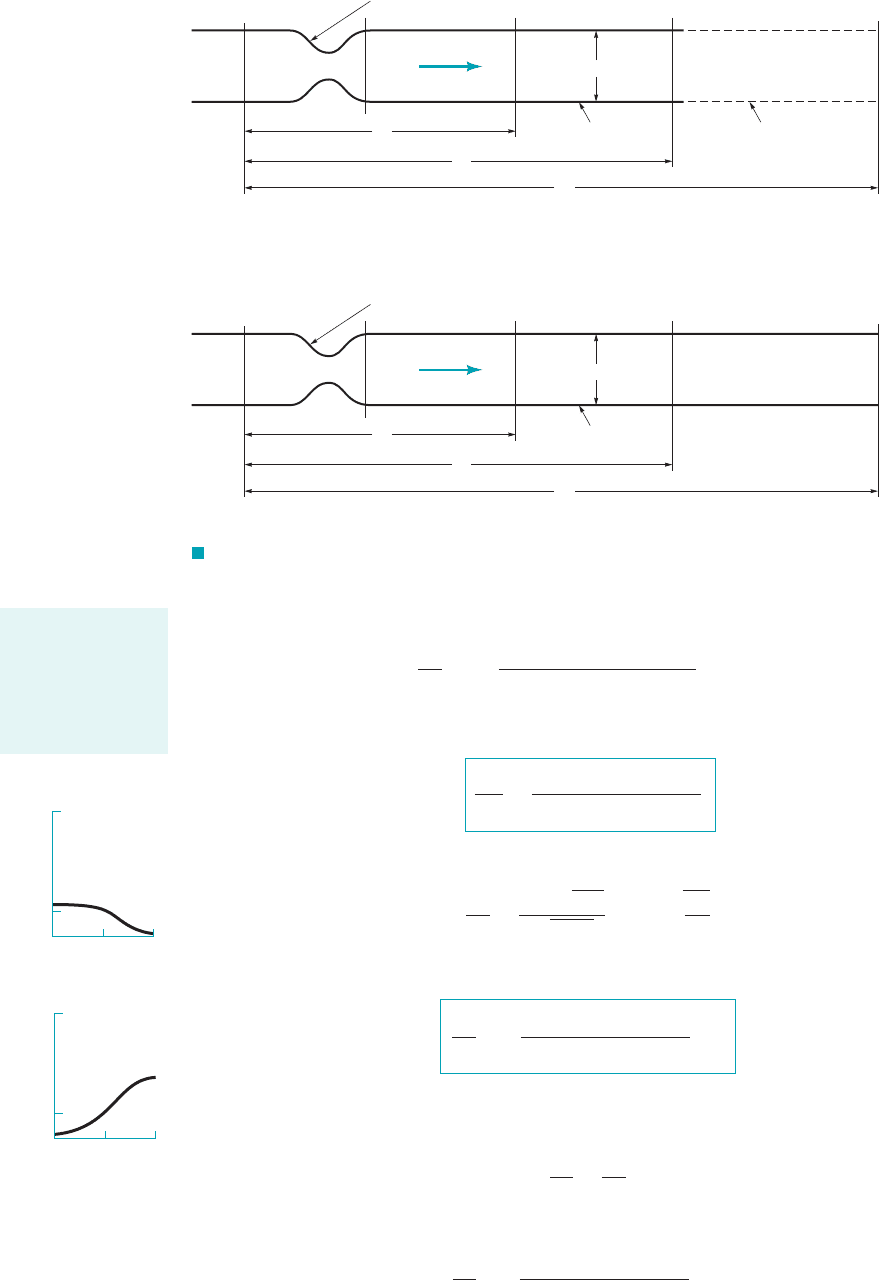Munson B.R. Fundamentals of Fluid Mechanics
Подождите немного. Документ загружается.


The isentropic flow behavior for the converging–diverging duct discussed in Examples 11.8,
11.9, and 11.10 is summarized in the area ratio–Mach number graphs sketched in Fig. 11.11. The
points a, b, and c represent states at axial distance 0 m, and In Fig. 11.11a,
the isentropic flow through the converging–diverging duct is subsonic without choking at the
throat. This situation was discussed in Example 11.10. Figure 11.11b represents subsonic to sub-
sonic choked flow 1Example 11.82and Fig. 11.11c is for subsonic to supersonic choked flow 1also
Example 11.82. The states in Fig. 11.11d are related to the supersonic to supersonic choked flow
of Example 11.9; the states in Fig. 11.11e are for the supersonic to subsonic choked flow of
Example 11.9. Not covered by an example but also possible are the isentropic flow states a, b,
and c shown in Fig. 11.11f for supersonic to supersonic flow without choking. These six cate-
gories generally represent the possible kinds of isentropic, ideal gas flow through a converging–di-
verging duct.
For a given stagnation state 1i.e., and fixed2, ideal gas and converging–
diverging duct geometry, an infinite number of isentropic subsonic to subsonic 1not choked2and
supersonic to supersonic 1not choked2flow solutions exist. In contrast, the isentropic subsonic
to supersonic 1choked2, subsonic to subsonic 1choked2, supersonic to subsonic 1choked2, and su-
personic to supersonic 1choked2flow solutions are each unique. The above-mentioned isentropic
1k ⫽ constant2,p
0
T
0
⫹0.5 m.x ⫽⫺0.5 m,
11.4 Isentropic Flow of an Ideal Gas 607
A
_
__
A*
1.0
0 1.0
Ma
(
a)(b)
a, c
b
A
___
A*
1.0
0 1.0
Ma
a, c
b
A
_
__
A*
1.0
0 1.0
Ma
(
c)(d)
c
a
b
A
___
A*
1.0
0 1.0
Ma
a, c
b
A
_
__
A*
1.0
0 1.0
Ma
(
e)(f )
a
c
b
A
___
A*
1.0
0 1.0
Ma
a, c
b
F I G U R E 11.11 (a) Subsonic to subsonic isentropic flow (not choked). (b) Subsonic to
subsonic isentropic flow (choked). (c) Subsonic to supersonic isentropic flow (choked). (d) Supersonic
to supersonic isentropic flow (choked). (e) Supersonic to subsonic isentropic flow (choked). (f) Supersonic
to supersonic isentropic flow (not choked).
A variety of flow
situations can oc-
cur for flow in a
converging–
diverging duct.
V11.5 Rocket
engine start-up
JWCL068_ch11_579-644.qxd 9/25/08 8:19 PM Page 607

flow solutions are represented in Fig. 11.12. When the pressure at 1exit2is greater
than or equal to indicated in Fig. 11.12d, an isentropic flow is possible. When the pressure
at is equal to or less than isentropic flows in the duct are possible. However, when
the exit pressure is less than and greater than as indicated in Fig. 11.13, isentropic flows
are no longer possible in the duct. Determination of the value of is discussed in Example
11.19.
Some possible nonisentropic choked flows through our converging–diverging duct are
represented in Fig. 11.13. Each abrupt pressure rise shown within and at the exit of the
flow passage occurs across a very thin discontinuity in the flow called a normal shock wave.
Except for flow across the normal shock wave, the flow is isentropic. The nonisentropic flow
equations that describe the changes in fluid properties that take place across a normal shock
wave are developed in Section 11.5.3. The less abrupt pressure rise or drop that occurs after
the flow leaves the duct is nonisentropic and attributable to three-dimensional oblique shock
waves or expansion waves 1see margin photograph2. If the pressure rises downstream of the
duct exit, the flow is considered overexpanded. If the pressure drops downstream of the duct
exit, the flow is called underexpanded. Further details about over- and underexpanded flows
and oblique shock waves are beyond the scope of this text. Interested readers are referred to
p
III
p
III
p
I
p
II
,x ⫽⫹0.5
p
I
x ⫽⫹0.5
608 Chapter 11 ■ Compressible Flow
–0.5 0
(
a)
x, m
+0.5
r
–0.5 0
(
c)
x, m
+0.5
T
–0.5
1.0
0
(
b)
x, m
+0.5
Ma
–0.5 0
(
d)
x, m
+0.5
p
p
I
I
p
I
F I G U R E 11.12 (a) The variation of duct radius with axial distance. (b) The variation of
Mach number with axial distance. (c) The variation of temperature with axial distance. (d) The variation
of pressure with axial distance.
p
x
p
I
p
III
p
II
F I G U R E 11.13 Shock formation in
converging–diverging duct flows.
Shock waves
V11.6 Supersonic
nozzle flow
Photographs courtesy
of NASA.
JWCL068_ch11_579-644.qxd 9/25/08 8:19 PM Page 608

11.5 Nonisentropic Flow of an Ideal Gas 609
Constant area duct
Fluid flow
F I G U R E 11.14 Constant area duct
flow.
11.4.3 Constant Area Duct Flow
For steady, one-dimensional, isentropic flow of an ideal gas through a constant area duct 1see
Fig. 11.142, Eq. 11.50 suggests that or that flow velocity remains constant. With the en-
ergy equation 1Eq. 5.692we can conclude that since flow velocity is constant, the fluid enthalpy
and thus temperature are also constant for this flow. This information and Eqs. 11.36 and 11.46
indicate that the Mach number is constant for this flow also. This being the case, Eqs. 11.59
and 11.60 tell us that fluid pressure and density also remain unchanged. Thus, we see that a
steady, one-dimensional, isentropic flow of an ideal gas does not involve varying velocity or
fluid properties unless the flow cross-sectional area changes.
In Section 11.5 we discuss nonisentropic, steady, one-dimensional flows of an ideal gas
through a constant area duct and also a normal shock wave. We learn that friction and兾or heat trans-
fer can also accelerate or decelerate a fluid.
dV ⫽ 0
Fluids in the News
Rocket nozzles To develop the massive thrust needed for space
shuttle liftoff, the gas leaving the rocket nozzles must be moving
supersonically. For this to happen, the nozzle flow path must first
converge, then diverge. Entering the nozzle at very high pressure
and temperature, the gas accelerates in the converging portion of
the nozzle until the flow chokes at the nozzle throat. Downstream
of the throat, the gas further accelerates in the diverging portion of
the nozzle (area ratio of 77.5 to 1), finally exiting into the atmos-
phere supersonically. At launch, the static pressure of the gas
flowing from the nozzle exit is less than atmospheric and so the
flow is overexpanded. At higher elevations where the atmospheric
pressure is much less than at launch level, the static pressure of
the gas flowing from the nozzle exit is greater than atmospheric
and so now the flow is underexpanded, the result being expansion
or divergence of the exhaust gas as it exits into the atmosphere.
(See Problem 11.49.)
11.5 Nonisentropic Flow of an Ideal Gas
Actual fluid flows are generally nonisentropic. An important example of nonisentropic flow involves
adiabatic 1no heat transfer2flow with friction. Flows with heat transfer 1diabatic flows2are generally
nonisentropic also. In this section we consider the adiabatic flow of an ideal gas through a constant
area duct with friction. This kind of flow is often referred to as Fanno flow. We also analyze the
diabatic flow of an ideal gas through a constant area duct without friction 1Rayleigh flow2. The con-
cepts associated with Fanno and Rayleigh flows lead to further discussion of normal shock waves.
11.5.1 Adiabatic Constant Area Duct Flow
with Friction (Fanno Flow)
Consider the steady, one-dimensional, and adiabatic flow of an ideal gas through the constant area
duct shown in Fig. 11.15. This is Fanno flow. For the control volume indicated, the energy equa-
tion 1Eq. 5.692leads to
01negligibly 01flow is adiabatic2
small for 01flow is steady
gas flow2 throughout2
m
#
ch
ˇ
2
⫺ h
ˇ
1
⫹
V
2
2
⫺ V
2
1
2
⫹ g1z
2
⫺ z
1
2d⫽ Q
#
net
in.
⫹ W
#
shaft
net in
Fanno flow involves
wall friction with
no heat transfer
and constant cross-
sectional area.
texts on compressible flows and gas dynamics 1for example, Refs. 4, 5, and 62for additional
material on this subject.
JWCL068_ch11_579-644.qxd 9/25/08 8:19 PM Page 609

or
(11.72)
where is the stagnation enthalpy. For an ideal gas we gather from Eq. 11.9 that
(11.73)
so that by combining Eqs. 11.72 and 11.73 we get
or
(11.74)
By substituting the ideal gas equation of state 1Eq. 11.12into Eq. 11.74 we obtain
(11.75)
From the continuity equation 1Eq. 11.402we can conclude that the density–velocity product,
is constant for a given Fanno flow since the area, A, is constant. Also, for a particular Fanno
flow, the stagnation temperature, is fixed. Thus, Eq. 11.75 allows us to calculate values of fluid
temperature corresponding to values of fluid pressure in the Fanno flow. We postpone our discus-
sion of how pressure is determined until later.
As with earlier discussions in this chapter, it is helpful to describe Fanno flow with a temper-
ature–entropy diagram. From the second T ds relationship, an expression for entropy variation was
already derived 1Eq. 11.222. If the temperature, pressure, and entropy, at the entrance of
the Fanno flow duct are considered as reference values, then Eq. 11.22 yields
(11.76)
Equations 11.75 and 11.76 taken together result in a curve with T–s coordinates as is illustrated in
Fig. 11.16. This curve involves a given gas 1 and R2with fixed values of stagnation temperature,
density–velocity product, and inlet temperature, pressure, and entropy. Curves like the one sketched
in Fig. 11.16 are called Fanno lines.
c
p
s ⫺ s
1
⫽ c
p
ln
T
T
1
⫺ R ln
p
p
1
s
1
,p
1
,T
1
,
T
0
,
rV,
T ⫹
1rV2
2
T
2
2c
p
1p
2
Ⲑ
R
2
2
⫽ T
0
⫽ constant
T ⫹
1rV2
2
2c
p
r
2
⫽ T
0
⫽ constant
T ⫹
V
2
2c
p
⫽ T
0
⫽ constant
h
ˇ
⫺ h
ˇ
0
⫽ c
p
1T ⫺ T
0
2
h
0
h
ˇ
⫹
V
2
2
⫽ h
ˇ
0
⫽ constant
610 Chapter 11 ■ Compressible Flow
F I G U R E 11.15 Adiabatic constant
area flow.
Adiabatic flow
Insulated wall
Control volume
Section (1) Section (2)
F I G U R E 11.16 The T–s
diagram for Fanno flow.
Entropy increases
in Fanno flows
because of wall
friction.
T
a
s
p
a
T
a
Constant entropy line
Fanno line
JWCL068_ch11_579-644.qxd 9/25/08 8:19 PM Page 610

11.5 Nonisentropic Flow of an Ideal Gas 611
GIVEN Air enters [section 112] an insulated, con-
stant cross-sectional area duct with the following properties:
p
1
⫽ 14.3 psia
T
1
⫽ 514.55 °R
T
0
⫽ 518.67 °R
1k ⫽ 1.42
Compressible Flow with Friction (Fanno Flow)
E
XAMPLE 11.11
S
OLUTION
Eq. 4 becomes
or
For psia we have from Eq. 1
or
Thus, since
we obtain
Hence,
(Ans)
where T is in
From Eq. 2, we obtain
or
(Ans)
Proceeding as outlined above, we construct the table of values
shown below and graphed as the Fanno line in Fig. E11.11. The
s ⫺ s
1
⫽ 33.6 1ft
#
lb2
Ⲑ
1lbm
#
°R2
⫺ 353.3 1ft
#
lb2
Ⲑ
1lbm
#
°R24 ln a
7 psia
14.3 psia
b
s ⫺ s
1
⫽ 3187 1ft
#
lb2
Ⲑ
1lbm
#
°R24 ln a
502.3 °R
514.55 °R
b
°R.
T ⫽ 502.3 °R
6.5 ⫻ 10
⫺5
T
2
⫹ T ⫺ 518.67 ⫽ 0
1 lb ⫽ 32.2 lbm
#
ft
Ⲑ
s
2
2.08 ⫻ 10
⫺3
31lbm
#
ft
Ⲑ
s
2
2
Ⲑ
1lb
#
°R24 T
2
⫹ T ⫺ 518.67 °R ⫽ 0
⫽ 518.67 °R
T ⫹
316.7 lbm
Ⲑ
1ft
2
#
s24
2
T
2
23187 1ft
#
lb2
Ⲑ
1lbm
#
°R24
17 psia2
2
1144 in.
2
Ⲑ
ft
2
2
2
353.3 1ft
#
lb2
Ⲑ
1lbm
#
°R24
2
p ⫽ 7
rV ⫽ 16.7 lbm
Ⲑ
1ft
2
#
s2
rV ⫽
114.3 psia21144 in.
2
Ⲑ
ft
2
20.211112 ft
Ⲑ
s2
353.3 1ft
#
lb2
Ⲑ
1lbm
#
°R241514.55 °R2
To plot the Fanno line we can use Eq. 11.75
(1)
and Eq. 11.76
(2)
to construct a table of values of temperature and entropy change
corresponding to different levels of pressure in the Fanno flow.
We need values of the ideal gas constant and the specific heat
at constant pressure to use in Eqs. 1 and 2. From Table 1.7 we read
for air
From Eq. 11.14 we obtain
(3)
or
From Eqs. 11.1 and 11.69 we obtain
and is constant for this flow
(4)
But
and from Eq. 11.56
Thus, with
⫽ 1112 ft
Ⲑ
s
⫽ 196 31ft
#
lb2
Ⲑ
lbm4
1
Ⲑ
2
3132.2 lbm
#
ft
Ⲑ
s
2
2
Ⲑ
lb4
1
Ⲑ
2
2RT
1
k ⫽ 211.42353.3 1ft
#
lb2
Ⲑ
1lbm
#
°R241514.55 °R2
Ma
1
⫽
A
a
1
0.992
⫺ 1
b
Ⲑ
.02 ⫽ 0.2
T
1
T
0
⫽
514.55 °F
518.67 °R
⫽ 0.992
rV ⫽ r
1
V
1
⫽
p
1
RT
1
Ma
1
1RT
1
k
rV
rV ⫽
p
RT
Ma1RTk
⫽ 187 1ft
#
lb2
Ⲑ
1lbm
#
°R2
c
p
⫽
353.3 1ft
#
lb2
Ⲑ
1lbm
#
°R2411.42
1.4 ⫺ 1
c
p
⫽
Rk
k ⫺ 1
⫽ 53.3 1ft
#
lb2
Ⲑ
1lbm
#
°R2R ⫽ 1716 1ft
#
lb2
Ⲑ
1slug
#
°R2
s ⫺ s
1
⫽ c
p
ln
T
T
1
⫺ R ln
p
p
1
T ⫹
1rV2
2
T
2
2c
p
p
2
Ⲑ
R
2
⫽ T
0
⫽ constant
FIND For Fanno flow, determine corresponding values of fluid
temperature and entropy change for various values of down-
stream pressures and plot the related Fanno line.
F I G U R E E11.11
550
500
450
400
350
300
35 40 45 50 55
T, °R
s – s
1
,
(ft
•
lb)
________
(lbm
•
°R)
JWCL068_ch11_579-644.qxd 9/25/08 8:20 PM Page 611

We can learn more about Fanno lines by further analyzing the equations that describe the
physics involved. For example, the second T ds equation 1Eq. 11.182is
(11.18)
For an ideal gas
(11.7)
and
(11.1)
or
(11.77)
Thus, consolidating Eqs. 11.1, 11.7, 11.18, and 11.77 we obtain
(11.78)
Also, from the continuity equation 1Eq. 11.402, we get for Fanno flow , or
(11.79)
Substituting Eq. 11.79 into Eq. 11.78 yields
or
(11.80)
By differentiating the energy equation 111.742obtained earlier, we obtain
(11.81)
dV
dT
⫽⫺
c
p
V
ds
dT
⫽
c
p
T
⫺ R a⫺
1
V
dV
dT
⫹
1
T
b
T ds ⫽ c
p
dT ⫺ RT a⫺
dV
V
⫹
dT
T
b
dr
r
⫽⫺
dV
V
rV ⫽ constant
T ds ⫽ c
p
dT ⫺ RT a
dr
r
⫹
dT
T
b
dp
p
⫽
dr
r
⫹
dT
T
r ⫽
p
RT
dh
ˇ
⫽ c
p
dT
T ds ⫽ dh
ˇ
⫺
dp
r
612 Chapter 11 ■ Compressible Flow
maximum entropy difference occurs at a pressure of 2.62 psia and
a temperature of 432.1
COMMENT Note that for Fanno flow the entropy must in-
crease in the direction of flow. Hence, this flow can proceed either
from subsonic conditions upstream to a sonic condition 12
downstream or from supersonic conditions upstream to a sonic
condition downstream. The arrows in Fig. 11.11 indicate in which
direction a Fanno flow can proceed.
Ma ⫽ 1
°R.
pT s s
1
(psia) ( ) [( )
兾兾
()]
7 502.3 33.6
6 496.8 39.8
5 488.3 46.3
4 474.0 52.6
3 447.7 57.3
2.62 432.1 57.9
2 394.7 55.4
1.8 378.1 53.0
1.5 347.6 47.0
1.4 335.6 44.2
lbm Rft lbR
Fanno flow proper-
ties can be obtained
from the second
T ds equation com-
bined with the con-
tinuity and energy
equations.
JWCL068_ch11_579-644.qxd 9/25/08 8:20 PM Page 612

which, when substituted into Eq. 11.80, results in
(11.82)
The Fanno line in Fig. 11.16 goes through a state 1labeled state a2for which At this
state, we can conclude from Eqs. 11.14 and 11.82 that
(11.83)
However, by comparing Eqs. 11.83 and 11.36 we see that the Mach number at state a is 1. Since
the stagnation temperature is the same for all points on the Fanno line [see energy equation 1Eq.
11.742], the temperature at point a is the critical temperature, for the entire Fanno line. Thus,
Fanno flow corresponding to the portion of the Fanno line above the critical temperature must be
subsonic, and Fanno flow on the line below must be supersonic.
The second law of thermodynamics states that, based on all past experience, entropy can only
remain constant or increase for adiabatic flows. For Fanno flow to be consistent with the second
law of thermodynamics, flow can only proceed along the Fanno line toward state a, the critical
state. The critical state may or may not be reached by the flow. If it is, the Fanno flow is choked.
Some examples of Fanno flow behavior are summarized in Fig. 11.17. A case involving subsonic
Fanno flow that is accelerated by friction to a higher Mach number without choking is illustrated
in Fig. 11.17a. A supersonic flow that is decelerated by friction to a lower Mach number without
choking is illustrated in Fig. 11.17b. In Fig. 11.17c, an abrupt change from supersonic to subsonic
flow in the Fanno duct is represented. This sudden deceleration occurs across a standing normal
shock wave that is described in more detail in Section 11.5.3.
The qualitative aspects of Fanno flow that we have already discussed are summarized in
Table 11.1 and Fig. 11.18. To quantify Fanno flow behavior we need to combine a relation-
ship that represents the linear momentum law with the set of equations already derived in this
chapter.
T*
T*,
V
a
⫽ 1RT
a
k
ds
Ⲑ
dT ⫽ 0.
ds
dT
⫽
c
p
T
⫺ R a
c
p
V
2
⫹
1
T
b
11.5 Nonisentropic Flow of an Ideal Gas 613
F I G U R E 11.17 (a) Subsonic Fanno flow. (b) Supersonic Fanno flow. (c) Normal shock
occurrence in Fanno flow.
T
s
(a)
1
2
a
T
s
(b)
1
2
a
T
s
(c)
1
2
Normal shock
a
Friction accelerates
a subsonic Fanno
flow.
TABLE 11.1
Summary of Fanno Flow Behavior
Flow
Parameter Subsonic Flow Supersonic Flow
Stagnation temperature Constant Constant
Ma Increases Decreases
1maximum is 121minimum is 12
Friction Accelerates flow Decelerates flow
Pressure Decreases Increases
Temperature Decreases Increases
F I G U R E 11.18 Fanno flow.
T
1
T
0
T*
a
p
0, I
p
1
p
1'
p
0, a
T
1'
JWCL068_ch11_579-644.qxd 9/25/08 8:20 PM Page 613

If the linear momentum equation 1Eq. 5.222is applied to the Fanno flow through the control
volume sketched in Fig. 11.19a, the result is
where is the frictional force exerted by the inner pipe wall on the fluid. Since and
we obtain
(11.84)
The differential form of Eq. 11.84, which is valid for Fanno flow through the semi-infinitesimal
control volume shown in Fig. 11.19b,is
(11.85)
The wall shear stress, is related to the wall friction factor, f, by Eq. 8.20 as
(11.86)
By substituting Eq. 11.86 and into Eq. 11.85, we obtain
(11.87)
or
(11.88)
Combining the ideal gas equation of state 1Eq. 11.12, the ideal gas speed-of-sound equation 1Eq.
11.362, and the Mach number definition 1Eq. 11.462with Eq. 11.88 leads to
(11.89)
Since then
or
(11.90)
d1V
2
2
V
2
⫽
d1Ma
2
2
Ma
2
⫹
dT
T
V
2
⫽ Ma
2
RTk
V ⫽ Ma c ⫽ Ma 1RTk,
dp
p
⫹
fk
2
Ma
2
dx
D
⫹ k
Ma
2
2
d1V
2
2
V
2
⫽ 0
dp
p
⫹
f
p
rV
2
2
dx
D
⫹
r
p
d1V
2
2
2
⫽ 0
⫺dp ⫺ fr
V
2
2
dx
D
⫽ rV dV
A ⫽ pD
2
Ⲑ
4
f ⫽
8t
w
rV
2
t
w
,
⫺dp ⫺
t
w
pD dx
A
⫽ rV dV
p
1
⫺ p
2
⫺
R
x
A
⫽ rV1V
2
⫺ V
1
2
m
#
⫽ rAV ⫽ constant,
A
1
⫽ A
2
⫽ AR
x
p
1
A
1
⫺ p
2
A
2
⫺ R
x
⫽ m
#
1V
2
⫺ V
1
2
614 Chapter 11 ■ Compressible Flow
Friction forces in
Fanno flow are
given in terms of
the friction factor.
F I G U R E 11.19 (a) Finite
control volume. (b) Semi-infinitesimal control
volume.
Flow
Section (1) Section (2)
Control volume
(
a)
p
1
A
1
R
x
p
2
A
2
Flow
Semi-infinitesimal control volume
(
b)
pA
x
D
w
(p + p)A
δ
τ
D
π
x
δ
δ
JWCL068_ch11_579-644.qxd 9/25/08 8:20 PM Page 614

The application of the energy equation 1Eq. 5.692to Fanno flow gave Eq. 11.74. If Eq. 11.74 is
differentiated and divided by temperature, the result is
(11.91)
Substituting Eqs. 11.14, 11.36, and 11.46 into Eq. 11.91 yields
(11.92)
which can be combined with Eq. 11.90 to form
(11.93)
We can merge Eqs. 11.77, 11.79, and 11.90 to get
(11.94)
Consolidating Eqs. 11.94 and 11.89 leads to
(11.95)
Finally, incorporating Eq. 11.93 into Eq. 11.95 yields
(11.96)
Equation 11.96 can be integrated from one section to another in a Fanno flow duct. We elect to
use the critical 1*2state as a reference and to integrate Eq. 11.96 from an upstream state to the crit-
ical state. Thus
(11.97)
where is length measured from an arbitrary but fixed upstream reference location to a section in
the Fanno flow. For an approximate solution, we can assume that the friction factor is constant at
an average value over the integration length, We also consider a constant value of k. Thus,
we obtain from Eq. 11.97
(11.98)
For a given gas, values of can be tabulated as a function of Mach number for
Fanno flow. For example, values of for air Fanno flow are graphed as a
function of Mach number in Fig. D.2 in Appendix D and in the figure in the margin. Note that the
critical state does not have to exist in the actual Fanno flow being considered, since for any two
sections in a given Fanno flow
(11.99)
The sketch in Fig. 11.20 illustrates the physical meaning of Eq. 11.99.
For a given Fanno flow 1constant specific heat ratio, duct diameter, and friction factor2the
length of duct required to change the Mach number from to can be determined from Eqs.
11.98 and 11.99 or a graph such as Fig. D.2. To get the values of other fluid properties in the Fanno
flow field we need to develop more equations.
Ma
2
Ma
1
f1/* ⫺ /
2
2
D
⫺
f1/* ⫺ /
1
2
D
⫽
f
D
1/
1
⫺ /
2
2
1k ⫽ 1.42f 1/* ⫺ /2
Ⲑ
D
f 1/* ⫺ /2
Ⲑ
D
1
k
11 ⫺ Ma
2
2
Ma
2
⫹
k ⫹ 1
2k
lne
31k ⫹ 12
Ⲑ
24Ma
2
1 ⫹ 31k ⫺ 12
Ⲑ
24Ma
2
f⫽
f1/* ⫺ /2
D
/* ⫺ /.
/
冮
Ma*⫽1
Ma
11 ⫺ Ma
2
2 d1Ma
2
2
51 ⫹ 31k ⫺ 12
Ⲑ
24 Ma
2
6kMa
4
⫽
冮
/*
/
f
dx
D
11 ⫺ Ma
2
2 d1Ma
2
2
51 ⫹ 31k ⫺ 12
Ⲑ
24Ma
2
6kMa
4
⫽ f
dx
D
1
2
11 ⫹ kMa
2
2
d1V
2
2
V
2
⫺
d1Ma
2
2
Ma
2
⫹
fk
2
Ma
2
dx
D
⫽ 0
dp
p
⫽
1
2
d1V
2
2
V
2
⫺
d1Ma
2
2
Ma
2
d1V
2
2
V
2
⫽
d1Ma
2
2
Ⲑ
Ma
2
1 ⫹ 31k ⫺ 12
Ⲑ
24Ma
2
dT
T
⫹
k ⫺ 1
2
Ma
2
d1V
2
2
V
2
⫽ 0
dT
T
⫹
d1V
2
2
2c
p
T
⫽ 0
11.5 Nonisentropic Flow of an Ideal Gas 615
For Fanno flow, the
Mach number is a
function of the dis-
tance to the critical
state.
5.0
0.0
101.0
Ma
0.1
f(ᐉ* – ᐉ)
________
D
JWCL068_ch11_579-644.qxd 9/25/08 8:21 PM Page 615

By consolidating Eqs. 11.90 and 11.92 we obtain
(11.100)
Integrating Eq. 11.100 from any state upstream in a Fanno flow to the critical 1*2state leads to
(11.101)
Equations 11.68 and 11.69 allow us to write
(11.102)
Substituting Eq. 11.101 into Eq. 11.102 yields
(11.103)
Equations 11.101 and 11.103 are graphed in the margin for air.
From the continuity equation 1Eq. 11.402we get for Fanno flow
(11.104)
Combining 11.104 and 11.103 results in
(11.105)
r
r*
⫽ e
1 ⫹ 31k ⫺ 12
Ⲑ
24Ma
2
31k ⫹ 12
Ⲑ
24Ma
2
f
1
Ⲑ
2
r
r*
⫽
V*
V
V
V*
⫽ e
31k ⫹ 12
Ⲑ
24Ma
2
1 ⫹ 31k ⫺ 12
Ⲑ
24Ma
2
f
1
Ⲑ
2
V
V*
⫽
Ma 1RTk
1RT*k
⫽ Ma
A
T
T*
T
T *
⫽
1k ⫹ 12
Ⲑ
2
1 ⫹ 31k ⫺ 12
Ⲑ
24Ma
2
dT
T
⫽⫺
1k ⫺ 12
251 ⫹ 31k ⫺ 12
Ⲑ
24Ma
2
6
d1Ma
2
2
616 Chapter 11 ■ Compressible Flow
F I G U R E 11.20 (a) Unchoked Fanno flow. (b) Choked Fanno flow.
Frictionless and adiabatic
converging–diverging duct
Reference
section
Section
(1)
Actual duct with
friction factor =
f
Section
(2)
Imagined
choked flow
section
Flow
Imagined duct
friction factor =
f
D = constant
ᐉ
1
ᐉ
2
ᐉ*
(a)
Frictionless and adiabatic
converging–diverging duct
Reference
section
Section
(1)
Actual duct with
friction factor =
f
Section
(2)
Actual
choked flow
section
Flow
D = constant
ᐉ
1
ᐉ
2
ᐉ*
(b)
5.0
1.0
0.0
101.0
Ma
0.1
T
__
T*
5.0
1.0
0.0
101.0
Ma
0.1
V
___
V*
For Fanno flow, the
length of duct
needed to produce a
given change in
Mach number can
be determined.
JWCL068_ch11_579-644.qxd 9/25/08 8:21 PM Page 616
